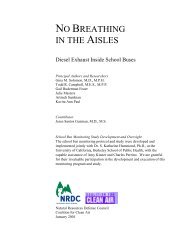US Nuclear Weapons in Europe - Natural Resources Defense Council
US Nuclear Weapons in Europe - Natural Resources Defense Council
US Nuclear Weapons in Europe - Natural Resources Defense Council
You also want an ePaper? Increase the reach of your titles
YUMPU automatically turns print PDFs into web optimized ePapers that Google loves.
U.S. <strong>Nuclear</strong> <strong>Weapons</strong> <strong>in</strong> <strong>Europe</strong> • Hans M. Kristensen/<strong>Natural</strong> <strong>Resources</strong> <strong>Defense</strong> <strong>Council</strong>, 2005<br />
guidance, NATO expla<strong>in</strong>ed <strong>in</strong> 2003, its “dual-capable aircraft posture has been further<br />
adapted, and read<strong>in</strong>ess requirements for these aircraft have been further relaxed.” 199 The<br />
read<strong>in</strong>ess of nuclear strike aircraft now should be measured <strong>in</strong> months, accord<strong>in</strong>g<br />
NATO. 200<br />
At the same time, the stock language was used to stress the importance of the U.S.<br />
nuclear weapons: “We cont<strong>in</strong>ue to place great value on the nuclear forces based <strong>in</strong><br />
<strong>Europe</strong> and committed to NATO, which provide an essential political and military<br />
l<strong>in</strong>kage between the <strong>Europe</strong>an and the North American members of the alliance.” 201 The<br />
subsequent NPG meet<strong>in</strong>g <strong>in</strong> December 2003 declared that the DCAs were ma<strong>in</strong>ta<strong>in</strong>ed at a<br />
read<strong>in</strong>ess level “consistent with the prevail<strong>in</strong>g security environment.” The contribution<br />
of the British Trident force to deterrence and the overall security of the allies were also<br />
highlighted. 202<br />
Figure 23:<br />
<strong>Nuclear</strong> Exercise at Incirlik Air Base<br />
The 39 th Security Force Squadron at Incirlik Air Base <strong>in</strong> Turkey held a<br />
nuclear weapons “recapture and recovery exercise” at a Protective<br />
Aircraft Shelter (PAS) on the flight l<strong>in</strong>e <strong>in</strong> April 2003. There are 56<br />
PAS at the base (see background), 25 with vaults <strong>in</strong>side them that<br />
store a total of 90 nuclear bombs. Source: U.S. Air Force.<br />
S<strong>in</strong>ce the 2001 NPR, the U.S. Air Force and NATO have been busy keep<strong>in</strong>g the nuclear<br />
capability <strong>in</strong> <strong>Europe</strong> up to date. Various awards are rout<strong>in</strong>ely given to Munitions Support<br />
Squadrons at the host nation bases, <strong>Nuclear</strong> Surety Inspections and NATO Tactical<br />
Evaluations are held regularly, and ma<strong>in</strong>tenance of the WS3 storage sites cont<strong>in</strong>ues.<br />
Both <strong>in</strong> January 2002 and July 2004, for example, the 48 th Fighter W<strong>in</strong>g at RAF<br />
Lakenheath practiced its nuclear skills. In April 2003, security forces of the 39 th Fighter<br />
W<strong>in</strong>g at Incirlik Air Base exercised defense aga<strong>in</strong>st a simulated attempt by hostile forces<br />
to ga<strong>in</strong> access to and capture nuclear weapons from a Protective Aircraft Shelter at the<br />
base (see Figure 23). In preparation for a subsequent Surety Inspection, members of the<br />
64
















